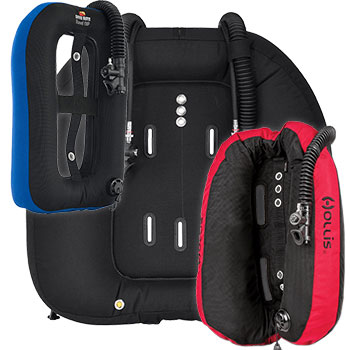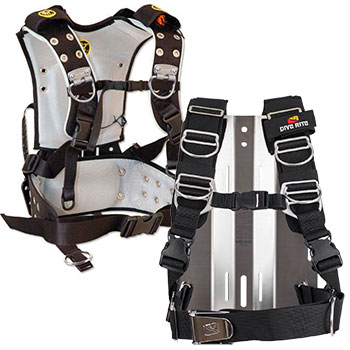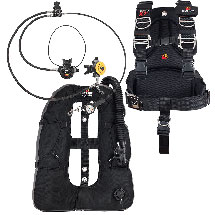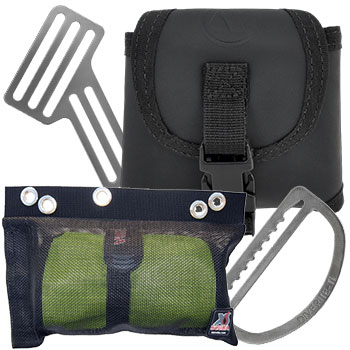Harnesses & Wings
Learn MoreHarnesses & Wings
A fundamental aspect of scuba diving is buoyancy control, which is where scuba harnesses and wings come into play. These pieces of equipment are vital for maneuverability and stability, allowing divers to navigate the depths with precision.
Scuba harnesses are designed to secure the diving tank and integrate weights effectively, while wings, which are a type of buoyancy control device (BCD), are attached to the harness and wrap around the tank. The wings allow divers to inflate and deflate air compartments to adjust buoyancy, thus facilitating a smooth ascent or descent in the water.
Our wide selection of harnesses and wings cater to both beginners and experienced tech divers, ensuring everyone has access to high-quality gear.
 Wings
Wings Harnesses
Harnesses PackagesLoading...
PackagesLoading...We take pride in helping divers find suitable harnesses and dive wings to enhance their underwater ventures. Our range includes various materials such as durable nylon webbing and features like lift bladders that are essential for technical diving. No matter the diving style or personal preference, Dive Right in Scuba has the ideal equipment to meet and exceed diving expectations.
Understanding Scuba Harnesses
Dive Right in Scuba offers a variety of scuba harnesses that accommodate every diver's needs. From snug fit to optimal control, these vital pieces of dive gear are crucial for a safe and enjoyable dive experience.
Read moreTypes and Benefits
Harnesses are the backbone of a diver's gear, holding tanks in place and attaching critical accessories. Modular harness systems offer customization to fit personal preferences and diving conditions. Traditional harnesses are sturdy and simple, usually made from continuous webbing for reliability.
Apeks harnesses are known for their quality and adjustability, providing tailored support and comfort. The benefits of a suitable harness include better trim, stability, and the ability to attach necessary accessories for different dive missions.
Selecting the Right Harness
Choosing the proper harness requires assessing your dive type, environment, and body shape. For technical diving, a one-piece harness with a backplate is crucial for managing heavy gear. Meanwhile, recreational divers might prefer the ease of an adjustable harness.
At Dive Right in Scuba, we guide you through our selection to ensure you pick a harness that fits your diving style, whether it's an Apeks for precision or a padded harness for comfort.
Fitting and Adjustment Tips
Correctly fitting a scuba harness is essential for both comfort and safety. Start by positioning the backplate so that it sits comfortably against your back. The straps should allow for unrestricted breathing and movement.
We guide how to tighten or loosen the harness to ensure a secure fit without it being constrictive. Remember, a proper fit means better control and reduced fatigue during your dive. For divers looking for high-quality scuba gear, Dive Right in Scuba has what you need, with the biggest range and best pricing available.
Exploring Wings and Bladders
When we at Dive Right in Scuba talk about scuba diving gear, wings, and bladders are fundamental components for divers who value stability and control in the water. They provide customizable buoyancy and accommodate various diving scenarios, from recreational to technical diving.
Wing Designs and Features
Wings, or buoyancy cells, are a crucial part of the diver’s gear, designed to offer more freedom of movement compared to traditional BCDs. Wing design typically falls into two categories: the horseshoe and the donut.
The horseshoe wings have a single bladder with two lobes, whereas the donut wings encircle the diver's tank entirely, providing even air distribution. At Dive Right in Scuba, we offer a range of designs, including specialty sidemount wings and doubles wings, each catering to different diver preferences.
Lift Capacity and Buoyancy
The lift capacity of a wing is defined by how much weight it can offset, a crucial aspect for divers to achieve neutral buoyancy. It essentially relates to how much air the wing can hold, which is measured in pounds or kilograms.
It's important to match the wing's lift capacity with your dive gear’s weight and the type of dive. For tec divers carrying multiple cylinders, a wing with a higher lift capacity is essential. Our product selection includes wings with various lift capacities to suit single-tank leisure dives to complex technical setups.
Diving Wings vs BCD
The main distinction between a traditional BCD and diving wings lies in modularity and buoyancy control. Wings are part of a system that includes a backplate and a harness which can be adjusted or replaced separately. This modularity caters to a personalized fit and dive experience.
Conversely, a BCD is an all-in-one solution that combines the harness and buoyancy control. For divers seeking streamlined profiles with greater control over their dive configuration, wings provide an advantage in customization and hydrodynamics.
Combination Systems for Diving
In our extensive selection at Dive Right in Scuba, we recognize the importance of having a reliable combination system for diving that suits your needs for versatility and performance. Whether you're embarking on a technical dive or enjoying an excursion abroad, our range offers integrated systems, customizable configurations, and travel-friendly designs that focus on being lightweight and streamlined.
Integrated Systems
Scubapro X-Tek Range and WTX-D Series represent the pinnacle of integrated diving systems, combining the backplate, harness, and wing into one streamlined package. These systems are revered for their robust construction and the ability to support single or multiple tanks configurations.
Notable for their durability, these integrated systems are a top choice for divers seeking a reliable setup that is both cohesive and functional without the need to purchase separate components.
Customization and Accessories
When it comes to tailoring your dive rig, options like Hollis and Halcyon lead the market. They offer an assortment of accessible accessories and components, with the flexibility to modify your setup as your diving needs evolve. Customization is key for more seasoned divers who may require additional D-rings, storage pouches, or specific weighting solutions.
At Dive Right in Scuba, our selection aims to provide you with these customizable parts, ensuring that your rig can adapt to the diverse requirements of your diving ventures.
Travel-Friendly Options
Understanding the needs of the traveling diver, we strive to present travel-friendly options that don't compromise on quality. Lightweight and compact, these systems are specifically designed to be easily packed without adding significant weight to your luggage.
For divers on the go, lightweight and streamlined alternatives from Hollis and the Scubapro X-Tek range ensure that your mobility above water is just as efficient as your movement below the surface.
Technical Diving Setups
In technical diving, the right gear is crucial for safety and performance. Our Dive Right in Scuba expert team emphasizes the precise configuration of harnesses and wings, ensuring that they meet the rigorous demands of deep and complex dives.
Tech Dive Harness and Wing Requirements
Technical diving requires robust diving equipment to handle the rigorous demands underwater. A high-quality technical diving harness is typically a one-piece design, offering a streamlined profile and reducing potential failure points.
The material needs to be durable, such as heavy-duty nylon webbing, to withstand the harsh environmental conditions and the weight of multiple cylinders. The backplate, commonly made from steel or aluminum, is the core of the technical diver's rig, providing the necessary counterbalance for ideal trim and stability.
When it comes to wings, they must provide adequate lift to compensate for the weight of the equipment and the steel or aluminum cylinders carried by the technical diver. Dual bladder wings offer redundancy, important for safety in technical dives. Selecting the right wing involves ensuring it matches the dive type, whether that's with a single tank, sidemount, or a twinset.
Sidemount vs Backmount
The choice between sidemount and backmount configurations largely depends on the dive's nature, personal preference, and the environment. Sidemount diving positions the cylinders along the diver's sides instead of on the back. This setup provides better trim and easier access to valves, great for tight spaces or caves. It can also offer more comfort and flexibility, with better distribution of weight.
Backmount harnesses are aligned with traditional technical diving setups, with cylinders fixed on the back. This arrangement is suitable for dives that require multiple tanks, as it allows for streamlined equipment management and facilitates horizontal trim and stability. It's a time-tested configuration preferred by many deep and wreck divers for its familiarity and ease of managing large gas volumes.
Here For YouWe know looking at Scuba Gear can be challenging.
Real Dive Shop, Real Divers, Real Answers!
Click here to email us so we can help you find the best options. Want to talk to a live person? No worries!
Call us at 815 267 8400 or hit us up on live chat!They SayOur ServicesDRIS EventsCopyright © Dive Right in Scuba.All Rights Reserved.

